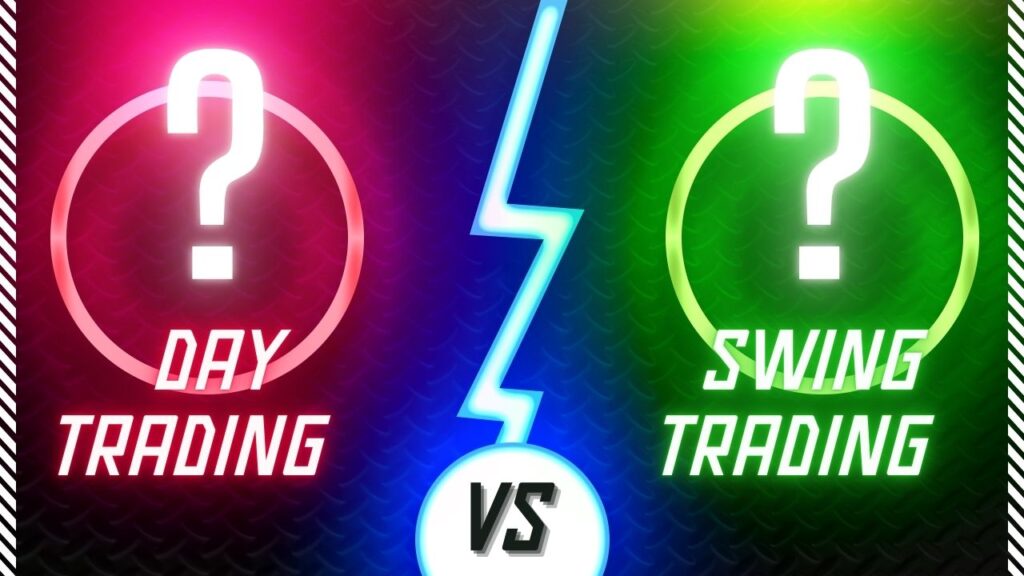
Day Trading vs Swing Trading – In trading, the correct methodology is all that matters to be successful. Among the most utilized trading methods, day trading and swing trading are typically discussed hand in hand as options for traders who try to make money from market fluctuations. Both techniques utilize market analysis to place trades, but they differ in time commitment, risk tolerance, as well as potential returns. So, if you’re a trader, the secret to finding out what works for your style, goals, and lifestyle is knowing the difference between day trading and swing trading. In this blog, we’re going to break down these two methods so you can make informed decisions.
What is Day Trading?
Day trading is short-term trading where day traders trade financial instruments, such as Forex, stocks, futures, or options, on the same day. Day traders primarily try to gain from small price fluctuations during a day using multiple trades, potentially in rapid succession. They tend to close all their positions before the end of the trading day to minimize exposure to overnight risk.
So, the big deal with day trading is the frequency of trades. Many day traders employ technical indicators, you know, such as Moving Averages, RSI, or Bollinger Bands, to make quick decisions about what to do based on real-time price movements. MetaTrader 4 and MetaTrader 5 are popular day trading platforms because they provide real-time charting, fast execution, and the capability to trade a wide range of trading instruments, such as E-mini Dow futures, S&P 500 futures, and forex currency pairs such as EUR/USD or GBP/USD.
Day Trading vs. Swing Trading – Day traders usually trade in very liquid markets where prices can change rapidly, e.g., mini S&P 500 futures or stocks of well-known companies like NVIDIA, Tesla, or Amazon. They might also use websites like TradingView to watch live price action and look for opportunities to make some short-term gains.
What is Swing Trading?
Day Trading vs Swing Trading – Swing trading is another popular method of trading, but one that differs from day trading in terms of trade duration. Swing traders try to capture larger price movements for a few days to weeks. Unlike day traders, who close positions at the end of the day, swing traders let their trades stay open for a few days or even more as they try to take advantage of medium-term trends in the market.
Swing trading involves a lot of technical analysis, chart patterns, and price action methods. Moving Averages, Fibonacci Retracement, and MACD are among the favorite tools of swing traders. Swing traders usually look to identify trends and support or resistance levels to know where to get in and out. So, like, a trader could use TradingView to spot an uptrend in S&P 500 mini futures and jump into a long position, holding onto it for a few days until the trend hits a major resistance level.
Swing traders will focus on fewer trades than day traders. They may only trade a few times a month, which allows them more time to analyze the overall market and economic conditions that move prices. This can be ideal for traders who have a longer timeframe and do not wish to process the speed and time commitment of day trading.
Key Differences Between Day Trading and Swing Trading
1. Time Commitment
One of the biggest distinctions between swing trading and day trading is the amount of time it takes. Day trading requires a trader to be available during the day, monitoring charts and making trades based on real-time price action. Traders spend an hour or more in front of their computer screens during the day, waiting for opportunities to move into and out of trades with speed.
So, swing trading is significantly less of a time drain. Yes, swing traders do still need to monitor the markets and adjust their positions when necessary, but they don’t need to be glued to the markets 24/7. This makes swing trading a good option for anyone who has other things on their plate or who just doesn’t want to be sitting there staring at the screen all day. Swing trading allows traders to invest a few hours a week monitoring charts and their positions.
2. Risk and Reward
Each of the approaches carries its own advantages and disadvantages. Day trading tends to be riskier since you’re performing many trades, and prices can vary significantly within a day. Day traders earn fewer profits for each trade but try to make up for it by conducting numerous trades. So, essentially, day traders can win small constantly, but they may also incur some fairly substantial losses if a trade does not go in their favor.
On the other hand, swing trading involves taking positions for longer durations, exposing traders to overnight risk and market action that can lead to price gaps. However, the profit potential is usually higher since swing traders aim to take advantage of larger price movements. Swing traders usually look for higher profit margins for each trade, holding on through market fluctuations and price corrections.
3. Market Analysis
The way people handle market analysis varies in day trading versus swing trading. Day traders are strictly short-term technical analysts in the sense that they might be examining things such as candlestick patterns, RSI, or Moving Averages in order to capitalize on immediate price movement throughout the day. They will utilize shorter time frames for their charts, e.g., the 1-minute or 5-minute chart, to find the best times to get in and out.
Swing traders, on the other hand, are all about those medium-term trends and they like to analyze charts on longer timeframes like the 4-hour or daily charts. They might also utilize price action and look for patterns like triangles, flags, or channels to make educated guesses as to where prices are headed next. Since they’re trying to capture larger moves, they really need to be tuned into the bigger picture things and economic news that might affect their trades for several days or even weeks.
4. Cost of Trading
You should also factor in the cost of trading as you decide which one to pick swing trading and day trading. Day trading costs you more since you keep making trades nonstop. Fees and commissions certainly pile up for every trade. While there are brokers like Interactive Brokers or WeBull who provide cheap commissions, there is still a need to watch costs if trades are high each day.
Swing trading, because you’re not always trading, generally has lower fee and commission costs. And since you keep your trades open longer, swing traders tend to use less leverage, which reduces the risk of losing a lot on margin calls.
5. Emotional Stress
Swing trading and day trading are both stressful, though to another degree. Day trading is more psychologically demanding since traders have to be attentive to price movements at all times. The fast pace of decision-making and the pressure to make a number of trades within a limited time frame can make traders tense and exhausted.
On the other hand, swing trading gives you more time to scan the market, yet there are still some emotional peaks and valleys for traders to deal with when they carry positions overnight or on major news days. To be certain, though, because swing traders trade less, they might have less mental strain than day traders.
What is your optimal strategy?
Deciding between day trading and swing trading really comes down to your trading style, your lifestyle, and your comfort level with risk. If you like making fast decisions and don’t mind spending a lot of time watching the market, then day trading may be your cup of tea. However, if you like a laid-back trading pace and don’t mind keeping a position overnight, then swing trading may be more your style.
If you are a beginner, it might be a good strategy to try both approaches with a demo account and determine which one you feel comfortable with. After you get accustomed to how things function, you can try out your strategy and adjust to the trading approach that best suits your objectives and personal energy.
Conclusion
Day trading and swing trading each have their pros and cons, and it simply comes down to what you like better. Day trading enables you to surf those immediate price movements within a day, whereas swing trading involves tracking the longer trends that take place over several days or weeks. By understanding the key differences between the two methods, you can choose the strategy that most suits your trading goals, available time, and risk tolerance. Whatever strategy you choose, discipline, risk management, and a solid trading plan are the keys to your success.
Read about the basics of Forex trading, check our blog post HERE



Pingback: Futures Trading Explained: A Beginner’s Guide to Getting Started - Trading Views
Pingback: Day Trading vs Swing Trading Strategy Works Best on TradingView - Trading Views
Pingback: Price Action vs Indicators: Which Wins in Day Trading? - Trading Views
Pingback: Crypto Tax Loopholes for Day Traders 2025
I simply had to say thanks once more. I am not sure the things that I would have handled without the actual thoughts discussed by you concerning that field. It previously was an absolute terrifying setting in my circumstances, however , finding out a new specialised avenue you solved the issue made me to jump with gladness. I will be happy for your advice and in addition hope you comprehend what a powerful job that you’re undertaking training men and women via your site. I know that you have never got to know any of us.
Pingback: Day Trading for Beginners: How to Start Making Profits Daily
I like what you guys are up also. Such intelligent work and reporting! Keep up the excellent works guys I’ve incorporated you guys to my blogroll. I think it will improve the value of my website 🙂
Thank you for sharing excellent informations. Your web site is so cool. I’m impressed by the details that you¦ve on this website. It reveals how nicely you perceive this subject. Bookmarked this website page, will come back for more articles. You, my friend, ROCK! I found just the information I already searched all over the place and just couldn’t come across. What an ideal website.
I have been browsing on-line greater than three hours lately, but I never discovered any interesting article like yours. It?¦s pretty worth enough for me. Personally, if all webmasters and bloggers made excellent content as you did, the web might be much more useful than ever before.
Way cool, some valid points! I appreciate you making this article available, the rest of the site is also high quality. Have a fun.
This blog is definitely rather handy since I’m at the moment creating an internet floral website – although I am only starting out therefore it’s really fairly small, nothing like this site. Can link to a few of the posts here as they are quite. Thanks much. Zoey Olsen